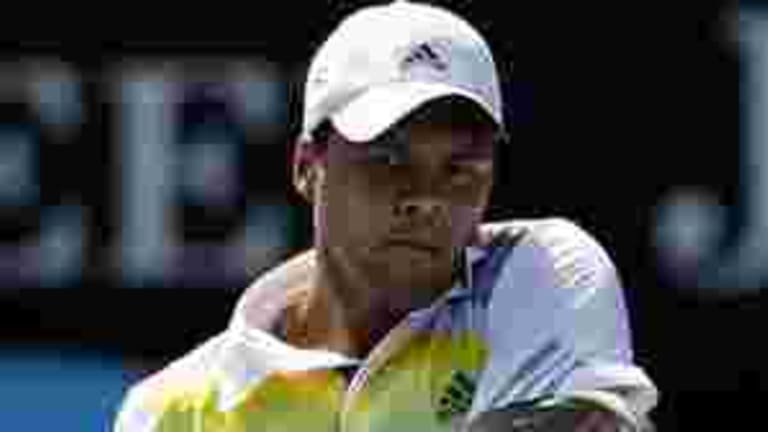
Australian Open: Tsonga d. Gasquet
Former finalist wins all-French fourth-rounder in four sets.
Published Jan 21, 2013

Australian Open: Tsonga d. Gasquet
Apparently, there really is no end to the ways Richard Gasquet can find to sabotage his chances of winning a tennis match. Today in his fourth-rounder with No. 7 seed and countryman Jo-Wilfried Tsonga, he quit mid-point to issue a challenge at 30-all in the first game of a must-win fourth set.
Naturally, the appeal was denied. Gasquet went down 30-40, and Tsonga bagged the ensuing break point when he walloped an inside-out forehand approach to force a backhand passing shot error. The sequence clearly dispirited Gasquet and caused him to lose his appetite for the battle.
In fact, Gasquet would win just two more games (when it no longer seemed to matter) before going quietly into the night as Tsonga won the contest, 6-4, 3-6, 6-3, 6-2. It was not the performance long-suffering Gasquet fans hoped (or deserved) to see, given the resurgence their hero produced last year. He’s made it back into the Top 10, and he was seeded just two ticks below the man who beat him today.
Surprisingly, these two paragons of French style had not squared off since the fall of 2009, and Gasquet led their head-to-head coming in, 4-3. The match promised fireworks, for Tsonga is a mercurial, explosive player who not only resembles Muhammad Ali but also “floats like a butterfly and stings like a bee.” Gasquet, for his part, has a baroque game, with big wind-ups and dramatic flourishes. You can easily picture him in a sepia-toned newsreel, hitting one of those trademark, roundhouse, one-handed backhands—after which he runs to leap over the net and shake the hand of his beaten rival.
Regrettably, that type of game is endangered in this era, which is ruled by efficient and compact strokes; Gasquet is Bernini in a Frank Lloyd Wright world.
Tsonga jumped out to an early lead, and didn’t have a speck of trouble until he served for the first set at 5-4. In typical Tsonga fashion—he sometimes seems half athlete, half riverboat gambler—he began that game with an ill-advised drop shot. A smash winner and whistling backhand pass later, it was 0-40. Gasquet’s best break point chance was his first one; he missed a routine cross-court backhand, after which Tsonga dialed in his big serve and clubbed a service winner and an ace to reach deuce. He held with another service winner followed by a prodigious down-the-line forehand.
The second set produced some highly entertaining tennis, as Tsonga’s level of intensity diminished (so what else is new?) and Gasquet lifted his game. Gasquet recorded his only break of the match in the fourth game, and while he served it out uneventfully, the pace was fast and the points brief and violent. Good stuff.
Gasquet got into trouble immediately in the third set, surrendering a break in the second game. One of Gasquet’s shortcomings is that his big wind-ups require a lot of time, so he’s naturally inclined to play too far behind the baseline. He makes some of his most spectacular shots from there, of course, but he’s prey to a player like Tsonga, who’s willing to push the action and advance to the forecourt.
With that early break in hand, Tsonga found the pop on his serve and the focus that he’d relaxed in the second set. He hit so huge a serve when he reached set point that it nearly wrenched the racquet from Gasquet’s hand.
Gasquet made the aforementioned fatal error of judgment in the first game of the fourth and final set, and he wandered right back into trouble after Tsonga held for 2-0. In the third game, Gasquet issued his third doomed challenge (exhausting his supply), after which his body language and carelessly fast play suggested his interest in the affair was waning. When he made a backhand volley error to hand Tsonga a second break, Gasquet smashed his racquet on the court.
Gasquet waved at the ball in a funk for a few more games, but ultimately had one more chance to keep the match going when Tsonga served at 5-2. Gasquet had three break points in that game, but a service winner and two groundstroke errors by Tsonga quashed his hopes. Tsonga won it on his first match point with—what else?—a service winner.
At 2:20, the match seemed to fly by; it was an agreeable spectacle, but that’s very different from a compelling match.